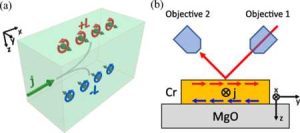Study of Physicists from Ohio State University Demonstrate Powerful Physics Phenomenon
Novel technique to confirm previously undetected physics phenomenon that could be used to improve storage in next-gen of computer devices
This is a Press Release edited by StorageNewsletter.com on October 23, 2023 at 2:02 pmIn a new breakthrough, researchers have used a novel technique to confirm a previously undetected physics phenomenon that could be used to improve data storage in the next-gen of computer devices.
(a) Schematics of the orbital Hall effect. The charge current j generates
a transverse orbital current, leading to orbital accumulation on the sample’s surfaces.
(b) Measurement setup utilizing the longitudinal MOKE
to detect the in-plane orbital accumulation.
Spintronic memories, like those used in some high-tech computers and satellites, use magnetic states generated by an electron’s intrinsic angular momentum to store and read information. Depending on its physical motion, an electron’s spin produces a magnetic current. Known as the ‘spin Hall effect,’ this has key applications for magnetic materials across many different fields, ranging from low power electronics to fundamental quantum mechanics.
![]() More recently, scientists have found that electrons are also capable of generating electricity through a second kind of movement: orbital angular momentum, similar to how Earth revolves around the sun. This is known as the ‘orbital Hall effect,’ said Roland Kawakami, co-author of the study, and professor in physics, The Ohio State University.
More recently, scientists have found that electrons are also capable of generating electricity through a second kind of movement: orbital angular momentum, similar to how Earth revolves around the sun. This is known as the ‘orbital Hall effect,’ said Roland Kawakami, co-author of the study, and professor in physics, The Ohio State University.
Theorists predicted that by using light transition metals – materials that have weak spin Hall currents – magnetic currents generated by the orbital Hall effect would be easier to spot flowing alongside them. Until now, directly detecting such a thing has been a challenge, but the study, led by Igor Lyalin, graduate student in physics, and published in the journal Physical Review Letters, showed a method to observe the effect.
“Over the decades, there’s been a continuous discovery of various Hall effects,‘’ said Kawakami. “But the idea of these orbital currents is really a brand new one. The difficulty is that they are mixed with spin currents in typical heavy metals and it’s difficult to tell them apart.”
Instead, his team demonstrated the orbital Hall effect by reflecting polarized light, in this case, a laser, onto various thin films of the light metal chromium to probe the metal’s atoms for a potential build-up of orbital angular momentum. After nearly a year of painstaking measurements, researchers were able to detect a clear magneto-optical signal which showed that electrons gathered at one end of the film exhibited strong orbital Hall effect characteristics.
“This successful detection could have huge consequences for future spintronics applications,“ said Kawakami. “The concept of spintronics has been around for about 25 years or so, and while it’s been really good for various memory applications, now people are trying to go further,” he said. “Now, one of the field’s biggest goals is to reduce the amount of energy consumed because that’s the limiting factor for jacking up performance.”
Lowering the total amount of energy needed for future magnetic materials to operate well could potentially enable lower power consumption, higher speeds and higher reliability, as well as help to extend the technology’s lifespan.
“Utilizing orbital currents instead of spin currents could possibly save both time and money in the long term,” said Kawakami.
Noting that this research opens up a way to learn more about how these strange physics phenomena arise in other kinds of metals, the researchers say they want to continue delving into the complex connection between spin Hall effects and orbital Hall effects.
Co-authors were Sanaz Alikhah and Peter M. Oppeneer, Uppsala University and Marco Berritta, both Uppsala University and the University of Exeter. This work was supported by the National Science Foundation, the Swedish Research Council, the Swedish National Infrastructure for Computing and the K. and A. Wallenberg Foundation.
Article: Magneto-Optical Detection of the Orbital Hall Effect in Chromium
Physical Review Letters has published an article written by Igor Lyalin, Sanaz Alikhah, Marco Berritta, Peter M. Oppeneer, and Roland K. Kawakami.
Abstract: “The orbital Hall effect has been theoretically predicted but its direct observation is a challenge. Here, we report the magneto-optical detection of current-induced orbital accumulation at the surface of a light 3d transition metal, Cr. The orbital polarization is in-plane, transverse to the current direction, and scales linearly with current density, consistent with the orbital Hall effect. Comparing the thickness-dependent magneto-optical measurements with ab initio calculations, we estimate an orbital diffusion length in Cr of 6.6±0.6 nm.“















 Subscribe to our free daily newsletter
Subscribe to our free daily newsletter


